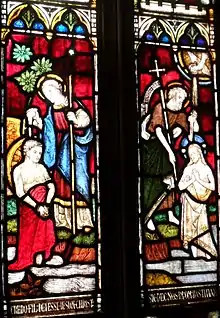Philip the Evangelist | |
|---|---|
 | |
| Evangelist or Deacon | |
| Born | Unknown (1st century) Caesarea Maritima |
| Died | 11 October (1st century) |
| Venerated in | Roman Catholic Church Eastern Catholic Churches Eastern Orthodox Church Coptic Orthodox Church Armenian Apostolic Church Ethiopian Orthodox Church Syriac Orthodox Church Oriental Orthodoxy Lutheranism Anglican Communion |
| Feast | 11 October |
Philip the Evangelist (Greek: Φίλιππος, Philippos) appears several times in the Acts of the Apostles. He was one of the Seven chosen to care for the poor of the Christian community in Jerusalem (Acts 6). He preached and reportedly performed miracles in Samaria, and met and baptised an Ethiopian man, a eunuch, on the road from Jerusalem to Gaza, traditionally marking the start of the Ethiopian Church (Acts 8:26–39). Later, Philip lived in Caesarea Maritima with his four daughters who prophesied, where he was visited by Paul the Apostle (Acts 21:8–9).
New Testament
Philip bore a Greek name. He is first mentioned in the Acts of the Apostles (6:5) as one of "Seven Deacons" who were chosen to attend to certain temporal affairs of the church in Jerusalem in consequence of the murmurings of the Hellenists against the Hebrews.
After the martyrdom of Stephen he went to "the city of Samaria", where he preached with much success, Simon Magus being one of his converts. He afterwards was told by an angel of the Lord to go to the road between Jerusalem and Gaza. There he instructed and baptized the Ethiopian eunuch; next he was "caught away" by the Spirit and "found at Azotus" (Ashdod); and then "passing through he preached in all the cities till he came to Caesarea" (Acts 8).
Here some years afterwards, according to Acts 21:8–9, where he is described as "the evangelist" (a term found again in the New Testament only in Ephesians 4:11; 2 Timothy 4:5), he entertained Paul the Apostle and his companion on their way to Jerusalem; at that time "he had four daughters, virgins, which did prophesy".[1]
Tradition

At a very early period he came to be confused with the Philip the Apostle; the confusion was all the more easy because, as an esteemed member of the apostolic company, he may readily have been described as an apostle in the wider sense of that word, beyond the original 12 Apostles.[2] A late tradition describes him as settling at Tralles in Anatolia, where he became the bishop of that church.[1]
Feasts
"St Philip the Deacon" is commemorated on October 11 in the Eastern Orthodox Church, in the Roman Rite,[3] the Lutheran Church–Missouri Synod,[4] and in the Anglican communion including, for example, the U.S. Episcopal Church, and the Anglican Church of Southern Africa.[5] Additionally, in the Eastern Orthodox Church, Philip is counted among the Seventy Apostles, and is referred to as a Protodeacon; this feast day is celebrated on January 4.
Notes
- 1 2 Chisholm, Hugh, ed. (1911). "Philip "the Evangelist"". Encyclopædia Britannica. Vol. 21 (11th ed.). Cambridge University Press. p. 376.
- ↑ Salmon, George (1894). A historical introduction to the study of the books of the New Testament (7th ed.). pp. 313-.
- ↑ Martyrologium Romanum (Editio Altera ed.). Typis Vaticanis. 2004. OCLC 254598655.
- ↑ Kinnaman, Scot A.; Lane, Laura L. (2010). Lutheranism 101. Concordia Publishing House. p. 278. ISBN 978-0-7586-2505-2.
- ↑ Lesser Feasts and Fasts 2018. Church Publishing, Inc. 17 December 2019. ISBN 978-1-64065-235-4.